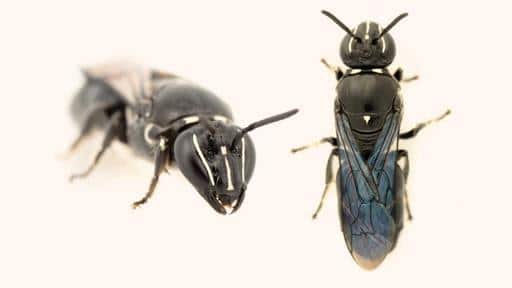
Rare Australian Bee Not Seen in 100 Years Is Spotted Again – But It’s in Danger

An oblique (left) and dorsal (right) photo of a female Pharohylaeus lactiferous. J.B. Dorey / Journal of Hymenoptera Research
Australia is one of the most biodiverse countries in the world. It is home to more than 7% of all the world’s plant and animal species, many of which are endemic. One such species, the Pharohylaeus lactiferus bee, was recently rediscovered after spending nearly 100 years out of sight from humans.
James B. Dorey, a Ph.D. student at Flinders University, was sampling more than 225 general and 20 targeted sites for research on native bee populations when he identified P. lactiferus among the specimens. Dorey took samples from areas around Queensland and New South Wales, two areas that have seen an increased loss of biodiversity in the past decades. Dorey recently published his findings in the Journal of Hymenoptera Research.
Prior to the study, the last publication on the bee species was recorded in 1923 in Queensland, with very little information on the bee’s biology. However, the study in the Journal of Hymenoptera Research indicates that this bee is in need of special attention. Dorey asserts that the species “requires conservation assessment,” due to its increasing loss of habitat.
Deforestation seems to be at the top of the list of concerns for P. lactiferus and neighboring species. WWF predicts that between 2015 and 2030, a mere 11 deforestation areas will account for more than 80% of global deforestation. Australia, specifically Queensland and New South Wales where P. laciferus resides, is in those top 11 regions. An alarming 80% of deforestation in Australia happens in the Queensland region, which threatens not only the endemic bee species but other iconic Australian species such as the koala.
However, Dorey cited bushfires as an equally dangerous threat to P. laciferus and other native bee species. Their dependence on the bushland for shelter and food nectar, coupled with habitat fragmentation from deforestation, has made the increasing intensity of Australian bushfires harder to survive. Dorey stated that “GIS analyses… indicate susceptibility of Queensland rainforests and P. lactiferus populations to bushfires, particularly in the context of a fragmented landscape.”
Dorey also noted that the 2019 and 2020 bushfire seasons “burnt a greater area than in any year prior,” for the habitats in which P. laciferus resides. However, the devastating bushfires of 2019 and 2020 are not only affecting the bees in Queensland, but are also potentially fueling the extinction crisis throughout Australia. University of Sydney ecologist, Chris Dickman, told Huffington Post that an estimated 1 billion species were affected during the wildfires. Compounding research on climate change indicates that the wildfire crisis is global, and P. laciferus might be next on the list of species affected.
However, there is hope for this rare bee and the other species facing real threats from the world’s extinction crisis. Dorey’s work in ecology research, as well as wildlife photography, is helping to fuel wildlife preservation in Australia and beyond. To see more of his work with native Australian bees, click here
Savannah Hasty is an environmental writer with more than six years of experience and has written thousands of articles for clients around the world. Her work focuses on environmental news, lifestyle content, and copywriting for sustainable brands. Savannah lives on the sunny coast of Florida and is inspired by this to play an active role in the preservation of the state’s marine life and natural ecosystems.
- 'Existential Threat to Our Survival': See the 19 Australian ...
- Could Rediscovery of Rare Owl Be a Hopeful Sign for Other 'Lost Birds'?

 233k
233k  41k
41k  Subscribe
Subscribe 